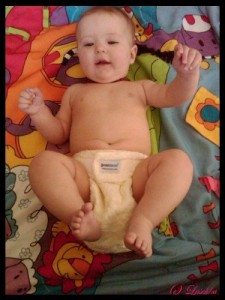Starting out with reusable nappies can be a real minefield. There are so many choices, and options that it can be a bit overwhelming.
Below is a summary of previous posts I’ve written on the subject – just click on the links for more detailed posts on the different subjects.
There are good reasons for switching to cloth:
 Environmental factors such as that in the UK we apparently go through 22,000 disposable nappies per day (8 million per year) and they take around 500 years to break down.
Environmental factors such as that in the UK we apparently go through 22,000 disposable nappies per day (8 million per year) and they take around 500 years to break down.- Costs: It is estimated that disposables will cost at least £800 per child for two years. Reusable nappies are less than £300, and there’s a fantastic resale market on them second hand too.
- Health: My daughter is a perfect example – she reacts to sodium polyacrylate, so badly that within days of birth, her disposable nappies made her bleed so badly she looked like she had been dragged over tar!
Once you’ve made the decision to make the move, it really gets complicated. There are just so many different varieties, styles and brands on the market, where to start can be a nightmare. A bit of independent advice is really useful.
There’s also hearing other people’s accounts of first-hand experience with cloth, specifically getting started and how they found it. You can also read Chelle McCann’s experience as a cloth user after she won a set of BumGenius from a competition I ran last year.
There are other great sources of information on the web. Babi Pur, for example have a whole reviews section for different types of nappies as tried by real parents. There’s also Go Real, the Real Nappy Network with information on council initiatives for real nappies.
And cloth users are a growing community – if not in your physical area, then online – so it’s easy to ask questions and get help.
If anyone asks me about how they can start out, here are my simple steps to getting started with real cloth nappies:
- Try a few different styles and shapes. The same nappies do not work the same for everyone, since babies have different body shapes, just as adults do. Some companies offer trial packs of different nappies to rent or buy.
- Once you’ve decided what you want, you can build up your kit over time. We started with just one nappy, then bought three more, then three more, then six in a half price sale and so on. We have loads now, probably around
2050, but it took time and careful searching for the best prices. It also means we don’t have all the same, which worked out better, because some are nice big fluffy bums, great for when babies are learning to walk and fall a lot (protects the spine), some are slimline, which is better for when Ameli is in jeans, for example, and some offer much more absorbency, which is ideal for night time use. - If you’re buying brand new nappies, read the instructions. Some nappies have to be washed three times before their first use to increase the absorbency. If you just use them straight away, they’re kind of like a duck’s back – which definitely gives the wrong impression of their capabilities.
- Ask, ask, ask. Whatever problem you’re facing, someone else has too. Whatever you’re hating, someone else did too – and possibly found a way around.
- ENJOY IT! If you’re like most others, you’ll find you soon loathe every time you either see your beautiful baby in plastic, or pop a disposable in the bin.
Thnak you for your article. I will try that
It is indeed very painful point, he was just a baby, and we produce on his back, so much waste. It’s a real shame. It seems to me that the best advice I can give to those starting, is to be in contact with other people doing the same thing and believe in it, so, there is always someone to consult, and receive support if necessary.